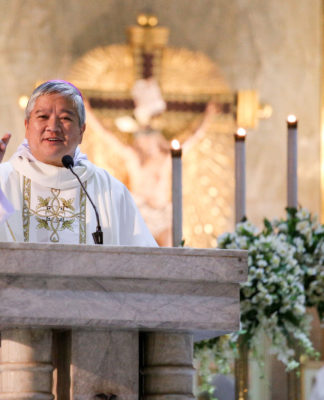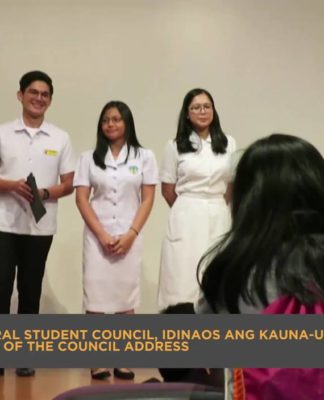heard of a “perspiring” or “bleeding” statue, or a “dancing” Sto. Niño? Or maybe a woman “possessed” by a certain ‘ingkong’ who has empowered her to heal the deadliest of diseases. Stay calm and pay close attention. Genuine apparitions will not resort to blackmail.
This is the advice of Fr. Nonnette C. Legaspi, head of the Manila Archdiocesan Office and Resource Center for Visions and Phenomena (OVP), to anyone who has seen on television, or experienced any religious ‘vision’, ‘communication’ or allegations attributing certain miraculous healings to these visions. He says genuine visions will not threaten anyone with punishments from heaven even if a genuine vision is rejected.
Legaspi revelaed the case of a lady visionary who once confided to him some “secret communications” she has been receiving from “God” since 1988.
“Convinced that the voice was God’s, she wanted God’s ‘voice’ to be heard by the Filipino bishops. In the course of my interview, she directly warned me of the sudden death of one priest who was skeptical of these messages!” Legaspi related. However, he said that this was unworthy of any attention and there is no reason to be un-Christian towards this soul who simply wanted to be listened to.
What to avoid
In any reported visions and phenomena, Legaspi said two extremes should be avoided: to see only the supernatural or miraculous and to refuse to recognize anything but the natural.
“The miseries of life coupled with many subjective factors such as weaknesses of faith, difficulties with regard to faith, one’s innate inclination to immediately ‘believe’ what is ‘seen’ and what I may call a spirituality propensity to ‘materialize’ or ‘physicalize’ divine responses to our prayers, have driven the Filipino Catholic to excessive credulity. Let everyone be advised that the danger of error is greater in credulity than in skepticism,” Legaspi cautioned.
As an example, Legaspi also cited the weeping image of Sacred Heart of Jesus in San Isidro Church, Pasay City, which has been reported as “milagroso.”
“Viewers who have the penchant for anything unusual and a desire for a material cause for one’s conversion or blessing, find themselves flocking to the Church. Doing so might ‘change’ them or give them a more personal faith experience than their ordinary Sunday Church attendance,” he said.
A closer examination revealed that the image was used as St. Joseph in an outdoor Nativity scene previous year which exposed it to the elements.
“The image was not seen ‘weeping’, no one witnessed its ‘weeping’. It however exhibits the marks of dried liquid droplets from the outer from the outer corner of the left eye down toward the middle of the left cheek,” Legaspi related..
Ask questions
Asked why people should not ignore such details, Legaspi said “not to pay any attention to an extraordinary vision or apparition is not at all helpful in intelligently addressing the issues. Experience tells us that the more we disregard them and easily dismiss them as anything but genuine the more unusual happenings pop in the news. Paying close attention to the details of the claim, while not promising to put a halt to the rise in number of these claims, opens the doors to a host of many important and subjective questions otherwise impossible to address without detailed information.”
He encouraged the faithful to ask discerning questions. He said he had often been asked, “Father, totoo ba ‘yung Agoo?” or “Father, totoo ba si Judiel Nieva?” (referring to the Agoo, La Union visionary whose case was declared by a diocesan commission in 1995 not as a hoax but as something far from being supernatural). He said that the tendency is to answer right off with, “Hindi, fake ‘yun or wala ‘yun!” You ask a vague question, you get a vague answer. You ask the wrong question, you get the wrong response.”
Legaspi said everyone should learn to ask right questions by further probing into their leads: “Totoong ano?” or “Ano ba ang gusto mong malaman tungkol doon?” even if what one wants to know is whether the entire case is authentic, supernatural communication or not.
He said other intelligible questions would be, how could the sun possibly dance? How was it possible that the visionary was getting all these messages which later proved to be culled from English translations of other apparition messages from all over the world?
Fr. Legaspi also said that the public should not dwell too much on the physical and the material. He said that people may flock to where the image of the Blessed Mother allegedly “wept tears of blood.”
Fr. Legaspi said “it is not so good when we consider how the public has always attached the label ‘miraculous’ on images more than directly attributing miracles t the Blessed Mother herself. With or without ‘images’ or ‘miracles’. Our prayers are constantly towards God in adoration and the Blessed Mother in veneration.”
In the past, Bishop Manuel Sobreviñas, former chairman of the archdiocesan commission and now director of Our Lady of Pillar Seminary in Imus, Cavite, said that even without any official pronouncement about the authenticity of any particular apparition, the faithful should find it necessary to pray, do penance, be converted, and work for peace.
Authenticated visions
In the last century, there were reports of visions and apparitions but only the Marian apparitions at Fatima, Portugal in 1917 were authenticated by the Church after 13 years of investigation.
Many books and magazines have been published and films have been shown narrating the entire drama of Fatima. But the book “Fatima in Lucia’s Own Words” is the most touching narrative. In it, she says the first visions she saw was actually that of an angel.
In the 1830’s, the phenomena at a convent chapel in Rue du Bac, France where the Blessed Virgin appeared as the Lady of the Miraculous Medal to Sister Catherine Laboure were given credence after two years o rigid investigation in her account, Sister Catherine testified she saw the Blessed Mother descend the steps of the altar, seat herself in a chair, and that she knelt down and placed her hands on Mary’s lap.
The Church also gave its stamp of approval to the visions of Bernadette Soubirous (later canonized in 1933) in Lourdes, France in 1858 after numberless spiritual transformations and physical cures were recorded. More importantly, the Marian apparition at Lourdes confirmed the dogma of the Immaculate Conception which was proclaimed by the Church four years earlier.
The celebrated ‘visions’ in Heroldsbach, Austria in 1949, in Garabandal, Spain (where the Blessed Virgin allegedly appeared to four little girls) in 1962, and in Cabra Island in Mindoro (where she “appeared” to eight visionaries) in 1967 have not been recognized by the Church as supernatural in nature.
The Medjugore apparitions in the former Yugoslavia (where the sun reportedly ‘danced’) from 1981 to 1987 are still under Church investigation and observation
Mrs. Lilia Alvarez, current textbook editor of Diwa Publications, wrote her article through the technical support of the “formally written response” of Fr. Nonette Legaspi, head of the Manila Archdiocesan Office and Resource Center for Visions and Phenomena, as her bases.
Mrs. Alvarez is a UST AB Communications Arts alumna, batch 1980.

















